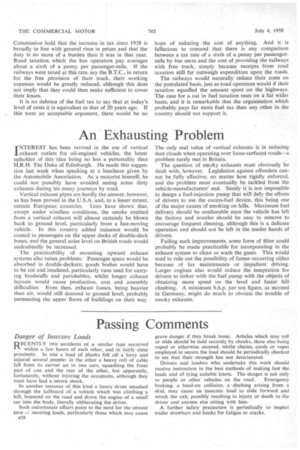An Exhausting Problem
Page 38

If you've noticed an error in this article please click here to report it so we can fix it.
INTEREST has been revived in the use of vertical exhaust outlets for oil-engined vehicles, the latest upholder of this idea being no less a personality than H.R.H. The Duke of Edinburgh. He made this suggestion last week when speaking at a luncheon given by the Automobile Association. As a motorist himself, he could not possibly have avoided seeing some dirty exhausts during his many journeys by road.
Vertical exhaust pipes are hardly the answer, however, as has been proved in the U.S.A. and, to a lesser extent, certain European countries. Tests have shown that, except under windless conditions, the smoke emitted from a vertical exhaust will almost certainly be blown back to ground level, particularly from a fast-moving vehicle. In this country added nuisance would be caused to passengers on the upper decks of double-deck buses, and the general noise level on British roads would undoubtedly be increased.
The practicability of mounting upward exhaust systems also raises problems. Passenger space would be absorbed in double-deckers; goods bodies would have to be cut and insulated, particularly vans used for carrying foodstuffs and perishables; whilst longer exhaust layouts would cause production, cost and assembly difficulties. Even then, exhaust fumes, being heavier than air, would still descend to ground level, probably permeating the upper floors of buildings on their way. The only real value of vertical exhausts is in reducing dust clouds when operating over loose-surfaced roads—a problem rarely met in Britain.
The question of smoky exhausts must obviously be dealt with, however. Legislation against offenders cannot be fully effective, no matter how rigidly enforced, and the problem must eventually be tackled from the vehicle-manufacturers' end. Surely it is not impossible to design a fuel-injection pump that will defy the efforts of drivers to use the excess-fuel device, this being one of the major causes of smoking on hills. Maximum fuel delivery should be unalterable once the vehicle has left the factory and nozzles should be easy to remove to encourage frequent cleaning, although this is a delicate operation and should not be left in the tender hands of drivers.
Failing such improvements, some form of filter could probably be made practicable for incorporating in the exhaust system to clean or wash the gases. This wOuld tend to rule out the possibility of fumes occurring either because of lax maintenance or impatient driving. Larger engines also would reduce the temptation for drivers to tinker with the fuel pump with the objects of obtaining more speed on the level and faster hill climbing. A minimum b.h.p. per ton figure, as mooted in Germany, might do much to obviate the trouble of smoky exhausts.




























































































































